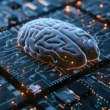Let’s explore the distinctions between real AI and simulated intelligence, examining the capabilities and limitations of LLMs in the context of cognitive processes, understanding, and creativity.
Understanding Intelligence
To navigate the discussion about LLMs, it is essential to define what constitutes “intelligence.” In humans, intelligence encompasses a range of cognitive abilities, including reasoning, problem-solving, emotional understanding, and adaptability. It involves not just the processing of information but also the capacity for self-awareness, consciousness, and intentionality. Real AI, as envisioned by researchers, would possess these qualities, enabling machines to understand context deeply and make autonomous decisions.
The Capabilities of LLMs
LLMs, powered by vast amounts of data and sophisticated algorithms, excel in specific tasks that mimic aspects of human intelligence:
- Natural Language Processing: LLMs are adept at understanding and generating human language, making them useful for applications like chatbots, content creation, and language translation. Their ability to produce coherent and contextually relevant text can sometimes create the illusion of understanding.
- Pattern Recognition: These models analyze vast datasets to identify patterns and relationships, allowing them to generate responses that align with human-like reasoning in specific contexts. This pattern recognition is a cornerstone of their functionality.
- Contextual Adaptation: LLMs can maintain context over the course of a conversation, making them seem more aware and engaged. They can adjust their responses based on user inputs, creating a dynamic interaction that feels natural.
The Limitations of LLMs
Despite their impressive capabilities, LLMs possess significant limitations that challenge the notion of them as “real” AI:
- Lack of Understanding: LLMs do not possess true comprehension of language or concepts. They operate based on statistical correlations and patterns learned during training, without any underlying awareness or intentionality. This means they can generate text that appears intelligent but lacks a genuine grasp of meaning.
- Absence of Consciousness: Unlike human beings, LLMs do not have consciousness or self-awareness. They do not possess thoughts, emotions, or subjective experiences. Their responses are generated based on algorithms rather than any form of cognitive processing or emotional engagement.
- Inability to Reason: While LLMs can simulate reasoning by producing text that follows logical structures, they do not engage in true reasoning processes. They lack the ability to engage in critical thinking, make judgments, or learn from experiences in the same way humans do.
Simulated Intelligence vs. Real AI
The distinction between simulated intelligence and real AI is crucial in understanding the capabilities of LLMs. Simulated intelligence refers to the ability to mimic human-like responses and behaviors without genuine understanding or consciousness. In contrast, real AI implies an autonomous system capable of reasoning, understanding, and adapting in a human-like manner.
LLMs exemplify simulated intelligence. They can perform specific tasks exceptionally well, yet they do so without the depth of understanding that characterizes human cognition. This raises ethical and philosophical questions about the implications of relying on systems that simulate intelligence, particularly in critical areas like education, healthcare, and customer service.
The Future of AI and LLMs
As research in AI continues to advance, the development of systems that bridge the gap between simulated intelligence and genuine understanding remains a priority. While LLMs are powerful tools for language processing, the pursuit of real AI involves creating systems that can think, learn, and understand in ways analogous to humans. This endeavor includes exploring areas such as cognitive architectures, reinforcement learning, and the integration of emotional intelligence into AI systems.
In conclusion, large language models represent a significant achievement in the field of artificial intelligence, showcasing remarkable capabilities in language generation and contextual interaction. However, they do not possess the qualities that define true intelligence, such as understanding, consciousness, and reasoning. As we continue to develop and integrate AI technologies into society, it is essential to recognize the limitations of LLMs and engage in thoughtful discussions about the implications of simulated intelligence in our daily lives. The future of AI will likely involve ongoing exploration of what it means to create machines that can genuinely understand and interact with the world in a human-like manner.







